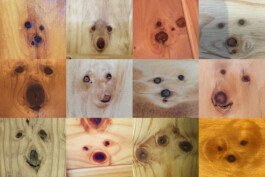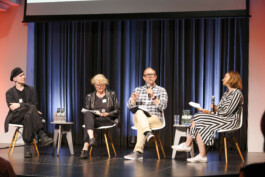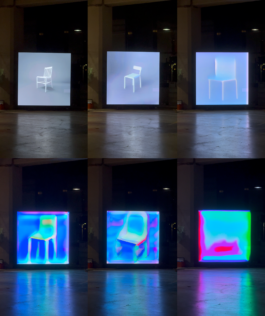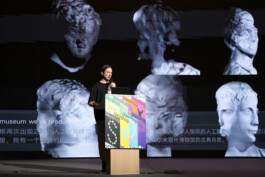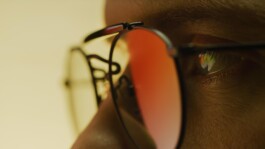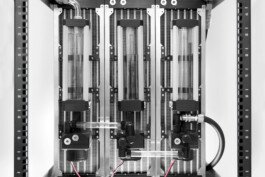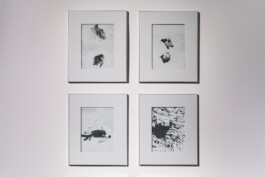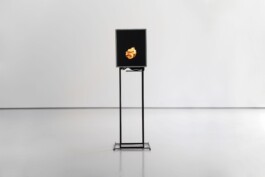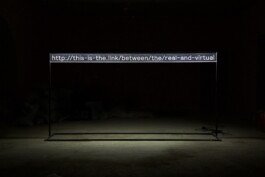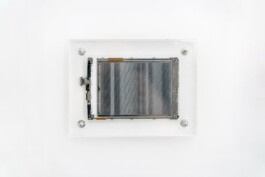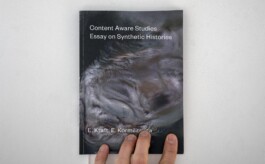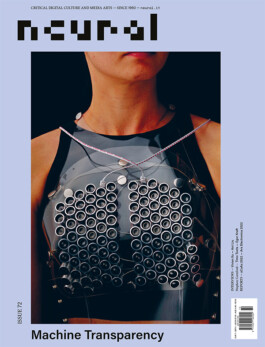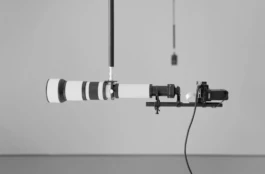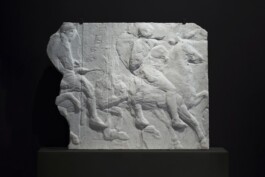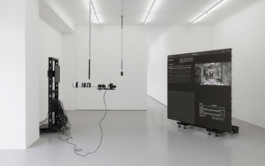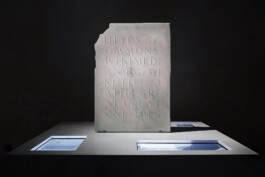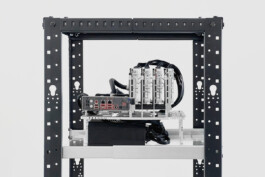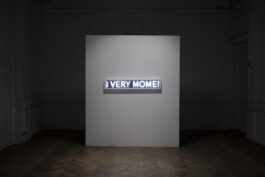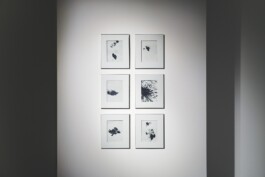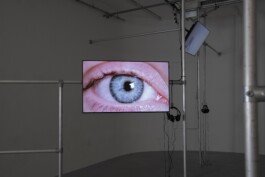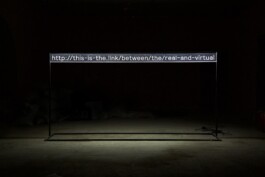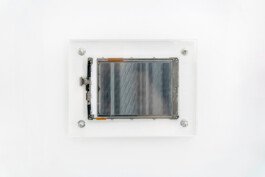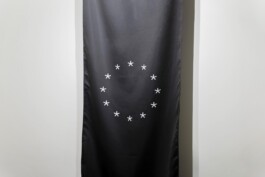One and Infinite Chairs
April, 2023.
Self hosted and custom trained Stable Diffusion; .ckpt-format file of a collapsed Ai model; essay-film, duration: 06’36”.
Collaborators:
AI engineer: Artem Konevskikh;
Voice: Sara Woodgate.
Hashterms
Images of chairs were generated by a Stable Diffusion deep learning model from the prompt 'a single chair on a white background'. The dataset was reused to retrain the model, as if to enhance its understanding of the given prompt. After six iterations, data cannibalism led the figurative chair image to become abstract digital noise, exposing susceptibility to corruption of computational ontology due to data feedback loops within Ai model echo chambers.
Joseph Kossuth’s ‘One & Three Chairs’ is the most textbook–introductory–example to conceptual art, as it touches upon a number of characteristics that are definitive of conceptual art. Art that emphasises the concept above all other perceptual content, it is associated with a dematerialisation of art. One & Three Chairs consists of some fairly obvious ingredients. Everything is in a one-to-one ratio here is a chair here is an image of a chair here is the written definition of a chair, and so you have three different representations of a chair. To substitute one chair with another would not diminish this work. This conceptual dematerialisation is often contextualised as a flight away from the commodity form. The work invites itself to be contextualised within various philosophical exercises, i.e. What is the concept of a chair? How does it include an image into its concept? How does it include the use value of a chair into the concept of what constitutes a chair? How language, art, and abstract concepts manifest in physical reality? What is the works' relationship to Platonic Forms? We can revisit Wittgenstein’s language and meaning, and challenge it against Hume's relations of ideas and matters of fact. And, of course, Kant’s critique of how the physical form of a chair conforms to our knowledge of how it can be used? Many of these questions within Western philosophical thought are thousands of years old. Duchamp’s iconic exercise was about how the institution takes claim over meaning and thus makes the meaning itself. In the context of Kosuth’s chairs, the art institution instantiates the assembly as a work of art. It does so out of nothing, it renders the artists useless. The artist is unnecessary, because this act of assembling these representations is rather an act of curation. It curates representations of chairs, in this case. Our expectation to see a work of art as an end in itself is an expectation of seeing an object that stands out from the world of objects, the world by access, as a means to another end. The way I access a chair to sit down, or the way I access a computer to look up art. However, I believe a computer is no longer merely an object that provides an access, as a means to another end. Computational assembly of information, synthetic cognitive capacities of Ai, and logistics of planetary scale interconnectedness not only change the way we institute knowledge, understand agential relationship and how we make art, but it also affects the very ontology of concepts. I would like to exercise this idea through an oddly titled work, '1&∞🪑'.
One & Infinite Chairs
Initial images of chairs were generated using the Stable Diffusion Ai model, based on the prompt: a single chair on a plain background. This dataset, of photo-realistic images of a wide variety of chairs, was then used to train the Stable Diffusion model again, extending its knowledge capacity of what a chair on a plain background can look like. This process of re-training the model on its own generated imagery was repeated again and again. Until, at the 6th iteration, instead of photo-realistic images of chairs, as seen in the initial step, the model produced colourful digital noise in which any resemblance to the represented subject, a chair, would fade completely. In another iconic conceptual sound artwork, I am sitting in a room, the author Alvin Lucier is recording himself narrating a text, and then playing the tape recording back into the room, re-recording it. The new recording is then played back and re-recorded, and this process is repeated. Due to the room's particular size and geometry, certain frequencies of the recording are emphasized while others are attenuated. Eventually the words become unintelligible, replaced by the characteristic resonant frequencies of the room itself. The text spoken by Lucier describes the very process of the act and predicts what will eventually happen to the recording of his voice. In data science, the phenomena of AI feeding into AI is often referred to as data-cannibalism. Through the necessity to augment datasets and due to AI image and data generation’s increasing and insidious prevalence, more and more new Ai systems will be trained on synthetic datasets, produced by generative Ai models, thus posing ontological challenges and poisoning future datasets. The epistemic accuracy of the popular Ai models, through a process of necessary and incidental feedback loops produce an echo chamber of auto-generated and consumed data where the domain ontology of a subject and its visual representation decay into non-figurative abstraction, at least so for a human eye.
1 & ∞ ⑁ film-essay trailer. Text: Ègor Kraft; Voice: Sara Woodgate
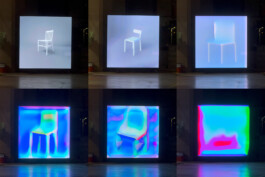
Installation wiew at Postcity, Linz, AUT

Chairs created by Stable Diffusion model
One and Infinite Chairs
April, 2023.
Self hosted and custom trained Stable Diffusion; .ckpt-format file of a collapsed Ai model; essay-film, duration: 06’36”.
Collaborators:
AI engineer: Artem Konevskikh;
Voice: Sara Woodgate.
Hashterms
Images of chairs were generated by a Stable Diffusion deep learning model from the prompt 'a single chair on a white background'. The dataset was reused to retrain the model, as if to enhance its understanding of the given prompt. After six iterations, data cannibalism led the figurative chair image to become abstract digital noise, exposing susceptibility to corruption of computational ontology due to data feedback loops within Ai model echo chambers.
Joseph Kossuth’s ‘One & Three Chairs’ is the most textbook–introductory–example to conceptual art, as it touches upon a number of characteristics that are definitive of conceptual art. Art that emphasises the concept above all other perceptual content, it is associated with a dematerialisation of art. One & Three Chairs consists of some fairly obvious ingredients. Everything is in a one-to-one ratio here is a chair here is an image of a chair here is the written definition of a chair, and so you have three different representations of a chair. To substitute one chair with another would not diminish this work. This conceptual dematerialisation is often contextualised as a flight away from the commodity form. The work invites itself to be contextualised within various philosophical exercises, i.e. What is the concept of a chair? How does it include an image into its concept? How does it include the use value of a chair into the concept of what constitutes a chair? How language, art, and abstract concepts manifest in physical reality? What is the works' relationship to Platonic Forms? We can revisit Wittgenstein’s language and meaning, and challenge it against Hume's relations of ideas and matters of fact. And, of course, Kant’s critique of how the physical form of a chair conforms to our knowledge of how it can be used? Many of these questions within Western philosophical thought are thousands of years old. Duchamp’s iconic exercise was about how the institution takes claim over meaning and thus makes the meaning itself. In the context of Kosuth’s chairs, the art institution instantiates the assembly as a work of art. It does so out of nothing, it renders the artists useless. The artist is unnecessary, because this act of assembling these representations is rather an act of curation. It curates representations of chairs, in this case. Our expectation to see a work of art as an end in itself is an expectation of seeing an object that stands out from the world of objects, the world by access, as a means to another end. The way I access a chair to sit down, or the way I access a computer to look up art. However, I believe a computer is no longer merely an object that provides an access, as a means to another end. Computational assembly of information, synthetic cognitive capacities of Ai, and logistics of planetary scale interconnectedness not only change the way we institute knowledge, understand agential relationship and how we make art, but it also affects the very ontology of concepts. I would like to exercise this idea through an oddly titled work, '1&∞🪑'.
One & Infinite Chairs
Initial images of chairs were generated using the Stable Diffusion Ai model, based on the prompt: a single chair on a plain background. This dataset, of photo-realistic images of a wide variety of chairs, was then used to train the Stable Diffusion model again, extending its knowledge capacity of what a chair on a plain background can look like. This process of re-training the model on its own generated imagery was repeated again and again. Until, at the 6th iteration, instead of photo-realistic images of chairs, as seen in the initial step, the model produced colourful digital noise in which any resemblance to the represented subject, a chair, would fade completely. In another iconic conceptual sound artwork, I am sitting in a room, the author Alvin Lucier is recording himself narrating a text, and then playing the tape recording back into the room, re-recording it. The new recording is then played back and re-recorded, and this process is repeated. Due to the room's particular size and geometry, certain frequencies of the recording are emphasized while others are attenuated. Eventually the words become unintelligible, replaced by the characteristic resonant frequencies of the room itself. The text spoken by Lucier describes the very process of the act and predicts what will eventually happen to the recording of his voice. In data science, the phenomena of AI feeding into AI is often referred to as data-cannibalism. Through the necessity to augment datasets and due to AI image and data generation’s increasing and insidious prevalence, more and more new Ai systems will be trained on synthetic datasets, produced by generative Ai models, thus posing ontological challenges and poisoning future datasets. The epistemic accuracy of the popular Ai models, through a process of necessary and incidental feedback loops produce an echo chamber of auto-generated and consumed data where the domain ontology of a subject and its visual representation decay into non-figurative abstraction, at least so for a human eye.
1 & ∞ ⑁ film-essay trailer. Text: Ègor Kraft; Voice: Sara Woodgate

Chairs created by Stable Diffusion model

Installation wiew at Postcity, Linz, AUT
Studio Addresses
Tokyo, Mishuku, JPN
Vienna, Neubau, AUT
Studio
Egor Kraft – artist-researcher, founder
Anna Kraft – researcher, director
Downloads
Contact
mail[at]kraft.studio
Studio Addresses
Tokyo, Mishuku, JPN
Vienna, Neubau, AUT
Contact
mail[at]kraft.studio
Downloads
Studio
Egor Kraft – artist-researcher, founder
Anna Kraft – researcher, director
